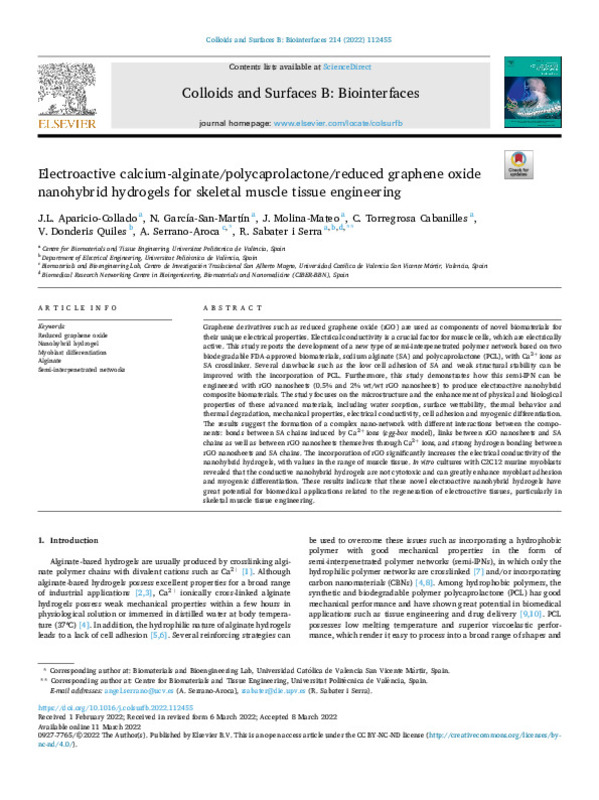JavaScript is disabled for your browser. Some features of this site may not work without it.
Buscar en RiuNet
Listar
Mi cuenta
Estadísticas
Ayuda RiuNet
Admin. UPV
Electroactive calcium-alginate/polycaprolactone/reduced graphene oxide nanohybrid hydrogels for skeletal muscle tissue engineering
Mostrar el registro sencillo del ítem
Ficheros en el ítem
| dc.contributor.author | Aparicio-Collado, José Luís
|
es_ES |
| dc.contributor.author | Garcia-San-Martin, N.
|
es_ES |
| dc.contributor.author | Molina Mateo, José
|
es_ES |
| dc.contributor.author | Torregrosa Cabanilles, Constantino
|
es_ES |
| dc.contributor.author | Donderis Quiles, Vicente
|
es_ES |
| dc.contributor.author | Serrano-Aroca, A.
|
es_ES |
| dc.contributor.author | Sabater i Serra, Roser
|
es_ES |
| dc.date.accessioned | 2023-07-25T18:01:49Z | |
| dc.date.available | 2023-07-25T18:01:49Z | |
| dc.date.issued | 2022-06 | es_ES |
| dc.identifier.issn | 0927-7765 | es_ES |
| dc.identifier.uri | http://hdl.handle.net/10251/195461 | |
| dc.description.abstract | [EN] Graphene derivatives such as reduced graphene oxide (rGO) are used as components of novel biomaterials for their unique electrical properties. Electrical conductivity is a crucial factor for muscle cells, which are electrically active. This study reports the development of a new type of semi-interpenetrated polymer network based on two biodegradable FDA-approved biomaterials, sodium alginate (SA) and polycaprolactone (PCL), with Ca2+ ions as SA crosslinker. Several drawbacks such as the low cell adhesion of SA and weak structural stability can be improved with the incorporation of PCL. Furthermore, this study demonstrates how this semi-IPN can be engineered with rGO nanosheets (0.5% and 2% wt/wt rGO nanosheets) to produce electroactive nanohybrid composite biomaterials. The study focuses on the microstructure and the enhancement of physical and biological properties of these advanced materials, including water sorption, surface wettability, thermal behavior and thermal degradation, mechanical properties, electrical conductivity, cell adhesion and myogenic differentiation. The results suggest the formation of a complex nano-network with different interactions between the components: bonds between SA chains induced by Ca2+ ions (egg-box model), links between rGO nanosheets and SA chains as well as between rGO nanosheets themselves through Ca2+ ions, and strong hydrogen bonding between rGO nanosheets and SA chains. The incorporation of rGO significantly increases the electrical conductivity of the nanohybrid hydrogels, with values in the range of muscle tissue. In vitro cultures with C2C12 murine myoblasts revealed that the conductive nanohybrid hydrogels are not cytotoxic and can greatly enhance myoblast adhesion and myogenic differentiation. These results indicate that these novel electroactive nanohybrid hydrogels have great potential for biomedical applications related to the regeneration of electroactive tissues, particularly in skeletal muscle tissue engineering. | es_ES |
| dc.description.sponsorship | Financial support from the Spanish Ministry of Science and Innovation (MCIN (Spain) , AEI/FEDER funds) through the projects RTI2018-097862-B-C21 and PID2020-119333RB-I00/AEI/10.13039/501100011033 are acknowledged. CIBER-BBN initiative is funded by the VI National R & D & I Plan 2008-2011, Iniciativa Ingenio 2010, Consolider Program. CIBER actions are financed by the Instituto de Salud Carlos III (Spain) with assistance from the European Regional Development Fund. | es_ES |
| dc.language | Inglés | es_ES |
| dc.publisher | Elsevier | es_ES |
| dc.relation.ispartof | Colloids and Surfaces B Biointerfaces | es_ES |
| dc.rights | Reconocimiento - No comercial - Sin obra derivada (by-nc-nd) | es_ES |
| dc.subject | Reduced graphene oxide | es_ES |
| dc.subject | Nanohybrid hydrogel | es_ES |
| dc.subject | Myoblast differentiation | es_ES |
| dc.subject | Alginate | es_ES |
| dc.subject | Semi-interpenetrated networks | es_ES |
| dc.subject.classification | INGENIERIA ELECTRICA | es_ES |
| dc.subject.classification | FISICA APLICADA | es_ES |
| dc.title | Electroactive calcium-alginate/polycaprolactone/reduced graphene oxide nanohybrid hydrogels for skeletal muscle tissue engineering | es_ES |
| dc.type | Artículo | es_ES |
| dc.identifier.doi | 10.1016/j.colsurfb.2022.112455 | es_ES |
| dc.relation.projectID | info:eu-repo/grantAgreement/AEI/Plan Estatal de Investigación Científica y Técnica y de Innovación 2017-2020/PID2020-119333RB-I00/ES/SOPORTES BIOFUNCIONALES CON CAPACIDAD OSTEOINDUCTORA Y ANTIMICROBIANA PARA INGENIERIA TISULAR OSEA/ | es_ES |
| dc.relation.projectID | info:eu-repo/grantAgreement/AEI/Plan Estatal de Investigación Científica y Técnica y de Innovación 2017-2020/RTI2018-097862-B-C21/ES/MICROENTORNOS BIOACTIVOS, ELECTROCONDUCTIVOS Y ANTIMICROBIANOS CON CAPACIDAD DE ESTIMULAR LA REGENERACION OSEA Y PREVENIR INFECCIONES MULTIRRESISTENTES/ | es_ES |
| dc.rights.accessRights | Abierto | es_ES |
| dc.contributor.affiliation | Universitat Politècnica de València. Escola Tècnica Superior d'Enginyeria Informàtica | es_ES |
| dc.contributor.affiliation | Universitat Politècnica de València. Escuela Técnica Superior de Ingeniería del Diseño - Escola Tècnica Superior d'Enginyeria del Disseny | es_ES |
| dc.contributor.affiliation | Universitat Politècnica de València. Escuela Politécnica Superior de Gandia - Escola Politècnica Superior de Gandia | es_ES |
| dc.description.bibliographicCitation | Aparicio-Collado, JL.; Garcia-San-Martin, N.; Molina Mateo, J.; Torregrosa Cabanilles, C.; Donderis Quiles, V.; Serrano-Aroca, A.; Sabater I Serra, R. (2022). Electroactive calcium-alginate/polycaprolactone/reduced graphene oxide nanohybrid hydrogels for skeletal muscle tissue engineering. Colloids and Surfaces B Biointerfaces. 214:1-13. https://doi.org/10.1016/j.colsurfb.2022.112455 | es_ES |
| dc.description.accrualMethod | S | es_ES |
| dc.relation.publisherversion | https://doi.org/10.1016/j.colsurfb.2022.112455 | es_ES |
| dc.description.upvformatpinicio | 1 | es_ES |
| dc.description.upvformatpfin | 13 | es_ES |
| dc.type.version | info:eu-repo/semantics/publishedVersion | es_ES |
| dc.description.volume | 214 | es_ES |
| dc.identifier.pmid | 35305322 | es_ES |
| dc.relation.pasarela | S\459160 | es_ES |
| dc.contributor.funder | Instituto de Salud Carlos III | es_ES |
| dc.contributor.funder | AGENCIA ESTATAL DE INVESTIGACION | es_ES |
| dc.contributor.funder | Agencia Estatal de Investigación | es_ES |
| dc.contributor.funder | European Regional Development Fund | es_ES |
| dc.contributor.funder | Ministerio de Ciencia e Innovación | es_ES |
| dc.contributor.funder | Universitat Politècnica de València | es_ES |








